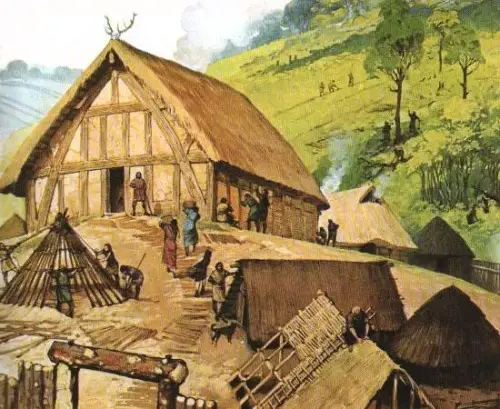|
Tuesday, November 11, 2025 Life in Anglo-Saxon England Part 2: How and Where People LivedSettlements
Residences As well, it was often not just one family or just two generations (parents and children) who lived in one house: Families often shared housing arrangements. (That sharing often extended to looking after one another's children if the parents were away.) Providing some warmth would have been the overall architecture: Houses were routinely built facing the Sun. Everyone's sleeping in the same room would provide body heat, as would, often, a family's animals, which made a practice of sleeping inside as well, with a screen to separate them from the sleeping humans. The poorest people had no beds and slept on the floor, which was just the ground, sometimes covered with rushes (because very few poor people could afford a carpet). Those who did have beds often had little other furniture. 
Those who served thanes slept on beds in a thane's hall. Even here, no glass windows were present; any windows would have had coverings to keep out the cold, but glass was one more thing that only the rich could afford. A thane's hall (and certainly a noble's residence) would have commonly had tapestries hanging on the walls and furniture dotting the room(s). Even the smallest of settlements often followed the pattern of homes surrounding a larger village hall. Most settlements also had churches, most of which were wooden but some of which were stone. Fences and, in some cases, walls ringed a settlement, to protect the people and their livestock from nocturnal predators like bears, foxes, and wolves. Forests were still large at this time, making it a bit easier to find materials for constructing buildings, but forests also hid wild animals and wild people, like outlaws. Part 3: Work, Food, and Clothing |
|
Social Studies for Kids
copyright 2002–2025
David White

 People in these times who had their own homes lived in wooden huts, with roofs that were thatched. A hut routinely had one large room. Beds could be stored during the day and set up at night. A cooking fire was the center of activity, and chimneys were rare. Candles were expensive, so the poor used something called a rush light, which was a rush dipped in animal fat and then set alight. (These were smoky and smelly.) Smoke from the fire and the rush lights escaped through a hole in the roof.
People in these times who had their own homes lived in wooden huts, with roofs that were thatched. A hut routinely had one large room. Beds could be stored during the day and set up at night. A cooking fire was the center of activity, and chimneys were rare. Candles were expensive, so the poor used something called a rush light, which was a rush dipped in animal fat and then set alight. (These were smoky and smelly.) Smoke from the fire and the rush lights escaped through a hole in the roof. 
